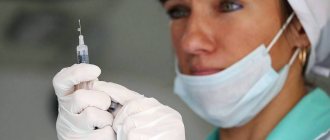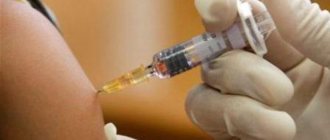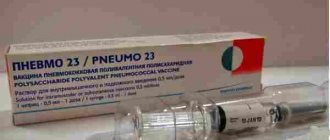Vaccine options
Vaccines against pneumococcal infection began to be developed only in the second half of the 20th century.
The difficulty in creating such vaccinations was (and is) the huge number of types of pneumococcus - more than 90 in total. First, a 14-valent vaccine was created. It began to be used in 1977. And in 1981 it was replaced by a 23-valent vaccine, which is still used today. But these vaccinations against pneumococcal infection could only be used by children from the age of two. And the most vulnerable group of young children still remained unprotected from pneumococci. Therefore, pharmaceutical companies around the world have begun developing a new generation of drugs - conjugate vaccines. The first such vaccine was the seven-valent pneumococcal conjugate vaccine Prevenar. It included seven types of pneumococcus, each of which was conjugated with non-toxic diphtheria protein and adsorbed on aluminum phosphate. The following vaccinations are currently used in Russia: Pneumo-23 (non-conjugated polysaccharide vaccine), 13-valent Prevenar 13, 10-valent Synflorix. Prevenar vaccinations can be administered to all children from 2 months of age, 10-valent Synflorix (polysaccharide, conjugated with D-protein of non-typeable Haemophilus influenzae, tetanus and diphtheria toxoids, adsorbed) - from 6 weeks and Pneumo-23 vaccination "- only from 2 years old.
Vaccinations against hepatitis and pneumonia - are they necessary?
We present to your attention an interview with the chief specialist in infectious diseases in children in the Central Administrative District and South-East Administrative District of Moscow, freelance consultant on infectious diseases at the Morozov Children's City Clinical Hospital of the Moscow Health Department, Candidate of Medical Sciences, Associate Professor of the Department of Foreign Diseases in Children of the Pension Fund of the Federal State Educational Institution of Higher Education Russian National Research Medical University named after. N.I. Pirogov of the Ministry of Health of Russia by Alexey Yuryevich Rtishchev on the topic: “Vaccinations against hepatitis and pneumonia - are they necessary?”
— Lately, discussions have often arisen about the need for vaccinations. What is this connected with? What is the professional position on this matter?
— Such discussions arise not only now. They have accompanied vaccination since the advent of the first smallpox vaccine, i.e. for more than 200 years. Only the content of these discussions changes in parallel with the development of medical science, education and culture of society. When vaccination against smallpox began, part of society believed that after the vaccine was administered, the vaccinated person could grow horns and hooves, since the cowpox virus was used to prepare the vaccine. Nowadays, such fears are unlikely to surprise anyone, so discussions and doubts concern other aspects. It cannot be said unequivocally that such discussions are absolutely unfounded, and they relate to completely different vaccination issues. On the one hand, there are doubts about the need for this or that vaccination in general and at a certain age, the effectiveness of individual vaccines, whether it is necessary to carry out some vaccinations en masse or whether it is sufficient to limit ourselves only to certain “risk groups”. On the other hand, and this is quite natural, the main and most heated discussions are related to the safety of a particular vaccine. A vaccine is a medicinal product, and, of course, it has certain contraindications, and there may be certain side effects or reactions.
In the modern world, it is obvious that the safety of vaccine drugs is carefully checked at the stage of clinical trials and then monitored in routine practice. Thanks to the Internet and the availability of this data, anyone can find information and see for themselves if they wish. The control system for immunobiological preparations, which include vaccines, is perhaps the strictest and most objective in the pharmaceutical world. Therefore, direct or indirect doubts that arise are carefully checked statistically and in additional studies.
The most popular myths of the last 20 years about the possible connection of vaccination with the subsequent development of autism, some autoimmune diseases and infertility have been completely refuted by a large number of studies in different countries of the world. There was also no confirmation of the adverse effects of the preservative merthiolate on the body. However, the latter simply ceased to be part of the vast majority of vaccines, so the discussion was exhausted. There is also a psychological moment. Vaccinations are prevention. It’s one thing to explain to a person suffering from a serious illness about the need to take a particular drug. Another is a person’s awareness of the need to administer a drug to prevent some disease, the danger and severity of which is quite difficult for him to imagine, and the chance of getting sick is sometimes theoretical.
Thanks to mass vaccination prevention, today in the world and in Russia, infections such as diphtheria, measles, tetanus or polio are rare or extremely rare, and the chance of getting sick is minimal. This creates a false impression of well-being and the optionality of vaccinations at this stage. The problem is that there will always be discussions and certain doubts around vaccines, since they accompany every person through life. There are and will be authors of the next “false” ideas who, due to their delusion or personal interest, will voice new theories about the harm and uselessness of vaccinations, actively preach and gather supporters and like-minded people. There have been and will be supporters of “conspiracy theories.”
— What is the difference between Russian and foreign vaccines? Which ones should you give preference to?
— Dividing vaccines exclusively into “foreign” and “Russian” is fundamentally wrong. A number of drugs that are used within the framework of the National Vaccination Calendar are not produced in Russia. For example, vaccines against rubella, pneumococcal and rotavirus infections, chickenpox, and inactivated polio vaccine are produced abroad. Vaccines against diphtheria, tetanus, hepatitis B or oral polio vaccine are no different from foreign analogues, and the principle of their production is the same all over the world. The same applies to the vaccine against tuberculosis - BCG. Vaccines against measles and mumps differ in the vaccine strain and the principle of its cultivation.
Fundamental differences relate primarily to vaccines against whooping cough, but these differences are not directly related to the country of origin. More modern and less reactogenic (giving fewer reactions after administration) - so-called cell-free drugs - are also not produced in our country. Combination vaccines, which can protect a child from several infections with one injection, are also not produced in Russia.
— How should children be vaccinated against hepatitis? At what age and with what frequency?
— It should be understood that the cause of hepatitis (liver inflammation) can be for various reasons. One of these reasons is viruses. Today, vaccinations against hepatitis A and B are widely used. Hepatitis A is an acute infection, which in some cases manifests itself as jaundice. The pathogen is transmitted through dirty hands, contaminated water or food. Currently in Russia, vaccination against this hepatitis is carried out mainly according to indications; the issue of mass vaccination is only being discussed. Another thing is hepatitis B. This disease is characterized by a chronic course, which can lead to serious consequences, such as cirrhosis or liver cancer. Infection occurs through contact with blood, including a minimal amount (the infectious dose is very small), and sexual contact. Teenagers and adults are more likely to become infected this way. But the virus can also be transmitted from mother to fetus during childbirth. In this case, the newborn develops a severe infection that often leads to death. That is why the relevance of protection against this infection arises immediately after the birth of a child. Against the backdrop of mass vaccination of the child population, which has been carried out in Russia since the late 90s, the incidence of acute hepatitis B in children has decreased by more than 160 times, chronic hepatitis B by 15 times, and carriage of the virus by 40 times. Now we register about 200-300 new cases annually.
The problem is that the incidence of the disease in adults is still high. Every year in Russia, hepatitis B is diagnosed in 20-30 thousand people, and the most important thing is that more than half of them are a chronic form of infection or carriage. In this case, the symptoms are erased or absent for a long time, and often such patients are identified by chance, during a routine examination. Therefore, in Russia, despite routine screenings of pregnant women, there remains a high risk of infection of the child at birth. It has been shown that in this case, protection of the newborn child can be ensured only by administering the vaccine as early as possible, within the first 24 hours after birth. Delaying vaccination even by a week no longer saves a newborn from developing a severe and potentially fatal form of the disease. That is why, as recommended by WHO, vaccination against hepatitis B in Russia begins in the first 24 hours after birth. The vaccination course does not depend on age and includes 3 injections of the vaccine. In case of proven infection of the mother and in the presence of contacts with patients or carriers, another, so-called “emergency” course of vaccination is provided.
Some countries, taking into account the significant reduction in the prevalence of hepatitis B among the population and, accordingly, the reduced risk in newborns, have postponed the start of vaccination of children to 2 months of life. However, this tactic turned out to be wrong. According to the latest reports, in Europe in 2015 and 2021, the leading route of infection in children is infection from the mother.
— Is it acceptable to refuse hepatitis vaccinations? How justified are parents' concerns about the safety of vaccinations?
— As in other countries, in Russia you can refuse both vaccination in general and a specific vaccination. Another thing is that hepatitis B vaccines are practically the only vaccines in the world that can be safely used immediately after birth and at any age without restrictions. Even reactions common to vaccinations (fever, local changes at the injection site) are extremely rare. All fears about the possible risk of multiple sclerosis and other conditions turned out to be unfounded and have now been scientifically refuted. Unfortunately, in Russia a situation has arisen where refusal of this vaccination immediately after birth is often due not to the initial reluctance of the child’s parents, but to unfounded recommendations or medical objections from an obstetrician-gynecologist or neonatologist.
— What are the risks of refusing hepatitis vaccinations?
— The risk of contracting hepatitis B exists throughout your life. There are misconceptions that only those who receive blood transfusions or other serious medical procedures are at risk of becoming infected, or that it can only happen to teenagers and adults who use intravenous drugs or have unsavory sexual relationships. The risk of virus transmission during medical procedures has now been reduced to almost zero thanks to the use of disposable instruments and vaccination of medical workers. The infectious dose is so insignificant that transmission of the virus can occur through household contacts, during manipulations in hairdressing salons or beauty salons, where sanitary requirements are still not always observed. Hepatitis B is an infection that can potentially lead to liver cancer (hepatocellular carcinoma), cirrhosis, and, in newborns, a severe (fulminant) infection that can be fatal.
— How should children be vaccinated against pneumonia? At what age and with what frequency?
— As in the case of hepatitis, pneumonia (pneumonia) comes in different forms. They can be caused by various pathogens, the leading of which is pneumococcus. In turn, pneumococcus causes not only pneumonia, but also other potentially dangerous conditions - meningitis and sepsis. At the same time, children in the first 5 years of life, as well as people over 60-65 years of age, are most susceptible to developing such dangerous conditions. Therefore, vaccination against pneumococcal infection sets as a task not only the prevention of pneumonia, but also any severe, so-called invasive forms of infection. Infants and young children die from meningitis and pneumococcal sepsis much more often than from pneumococcal pneumonia. For example, in 2021 in Russia, 369 cases of pneumococcal meningitis were laboratory confirmed. At the same time, in 17% of children in the first 5 years of life, the disease ended in death, in children in the first year of life - in 32%. Therefore, the risks are incredibly high starting from the first months of life.
Since 2014, vaccination against this infection has been included in the Russian vaccination calendar for all children starting from 2 months of life. The number of vaccine administrations depends on the age at which vaccination begins. With a timely start, the child is vaccinated three times during the first 1.5 years, premature infants - four times. In addition, older children are also susceptible to severe forms of pneumococcal infection if they have chronic diseases of the lungs, cardiovascular system, kidneys, diabetes mellitus and others. Children with autoimmune diseases are at a significantly higher risk of pneumococcal pneumonia. Such children are also vaccinated against pneumococcus. Currently, the vaccination course in this “risk group” is carried out by sequential administration of two pneumococcal vaccines - conjugate and polysaccharide.
— What concerns do parents have regarding vaccinations against pneumonia? How valid are they?
— Vaccines against pneumococcal infection today have the least number of myths and fears around them. They are least likely to be credited with various unjustified consequences. At the same time, these are the vaccines whose purpose of administration is poorly understood not only by parents, but also by some medical workers. Quite often, the pneumococcal vaccine is voiced as a means of reducing the incidence of illness in frequently ill children or as a means of boosting immunity. This is wrong. In addition, some doctors recommend delaying it until kindergarten. According to statistics, attending kindergarten does not increase the risk of severe forms of pneumococcal infection. Both organized and unorganized children are at risk.
— What are the risks of refusing vaccinations against pneumonia?
— Today, pneumococcal infection is the deadliest of the “preventable” infections in children under the first 5 years of life all over the world. It is impossible to predict the risk and probability of developing severe pneumococcal meningitis, sepsis or pneumonia in children of this age. There are no other methods of prevention other than vaccination. Asymptomatic carriage of pneumococcus in the upper respiratory tract is widespread among the population. Such carriers and sources of pneumococcus can be parents, grandmothers, older brothers and sisters.
— What would you recommend to parents who doubt the need for vaccinations for their children?
“People are different, and so are parents.” There are not so many obvious and absolute anti-vaxxers. Most often, parents doubt the need for certain vaccinations, their safety, and the advisability of administering them at an early age. This is where sources of information are critical. The main problem of modern society, which today, thanks to the Internet, has access to almost any and completely different information, is to develop the skills to study reliable and objective sources, and this, unfortunately, is not easy. The same goes for medical workers. It is quite obvious that parents make their decision about the need for vaccination, most often in consultation with doctors, whose opinion is authoritative for them. Therefore, today it is important to create simple, accessible and reliable resources that objectively explain the essence and purpose of vaccination, why certain vaccinations are needed, what judgments about the dangers of vaccinations are false and biased, and why. WHO and immunization specialists around the world are working on this. But it is impossible to give one optimal recommendation; communications with different parents require different approaches.
Interviewed by Maria Zelenskaya, Head of Public Relations of the Association of Medical Journalists, Chief Editor of the Digest of the Academy of Obstetrics and Gynecology magazine
Source: medwriters.ru
Principles and purposes of vaccination
Pneumococcal disease is one of the leading causes of morbidity and mortality worldwide. Serious diseases often caused by pneumococci include pneumonia, meningitis, and bacteremia with fever. In 2005, WHO estimated that 1.6 million people die each year from pneumococcal disease. Therefore it must be prevented.
By the end of 2013, pneumococcal vaccination had been introduced in 103 countries, and immunization coverage had reached 25%. By order of the Ministry of Health of the Russian Federation No. 125 of March 21, 2014, vaccination against pneumococcal infection was introduced into the National Calendar of Preventive Vaccinations of the Russian Federation.
Vaccine effectiveness
In international practice, since 2000, vaccination has been used for immunoprophylaxis of pneumococcal infection in newborns and young children. According to WHO, world experience has shown that mass vaccination reduces the incidence of pneumococcal meningitis and severe pneumonia in children by more than 80% and the incidence of all pneumonia and otitis media by more than a third. The carriage of pneumococci in children is decreasing, and accordingly, both unvaccinated children and adults get sick less.
The World Health Organization projects that global use of pneumococcal vaccinations will prevent 5.4-7.7 million child deaths by 2030. The Prevenar13 vaccine protects against the thirteen most common types of pneumococcus, which cause up to 80% of pneumococcal infections.
Contraindications
For pneumococcal conjugate vaccines: increased sensitivity to previous vaccination (severe generalized allergic reactions); hypersensitivity to diphtheria toxoid and/or excipients; acute infectious or non-infectious diseases, exacerbations of chronic diseases. Vaccinations against pneumococcal infection are carried out after recovery or during remission. Pneumococcal polysaccharide vaccines: pronounced reaction to the previous vaccination, PPV23 vaccination less than 3 years before the intended PPV23 vaccination.
Post-vaccination complications
Post-vaccination complications are very rare. On average, with a frequency of 1 in several hundred thousand children who received the vaccine. Severe complications – 1 in several million.
Complications after vaccination are divided into several large groups:
- Reaction to vaccine components. Such reactions include:
- development of an acute allergic reaction: Quincke's edema, urticaria, anaphylactic shock. Most often, these conditions occur without consequences, provided that assistance is provided in a timely and correct manner;
- a piercing scream. Occurs more often after DPT. 2-8 hours after vaccination, the child cries loudly, turning to squealing, for about 3 hours. This is a very unpleasant complication for parents, but it does not threaten the baby in any way.
- severe muscle weakness that goes away on its own. Occurs approximately 1-3 hours after vaccination.
- Reactions due to the quality of the vaccine. This includes changes that arise as a result of violations of the conditions of production, storage, and transportation of vaccines. When using such vaccinations, the following may occur:
— loss of vaccine activity (immunity is not formed);
- increased risk of severe local reactions;
- acute inflammatory changes (abscesses or phlegmon). This happens when the sterility of the drug is violated.
- Reactions caused by violation of the rules of drug administration. This reaction is typical for the BCG vaccine. If it is administered incorrectly intramuscularly, or subcutaneously, and not intradermally, an abscess may develop. When the vaccine is administered into the gluteal muscle, instead of the tibialis or deltoid, the risk of injury to the sciatic nerve and the development of inflammation of the subcutaneous fatty tissue increases. If antiseptic rules are violated, acute local or general inflammation may develop. It happens that vaccines intended for oral administration are administered by injection. This threatens with pronounced local or general reactions.
- Diseases caused by vaccination. Such complications, most likely, would have developed in the baby later, regardless of the vaccination, caused by other factors. For example, a past infection.
These include: arthritis, thrombocytopenic purpura, autoimmune diseases, immunodeficiency conditions. Separately, it is worth saying that in children with immunodeficiencies, the introduction of a vaccine can provoke the development of severe conditions: vaccine-associated poliomyelitis, BCG osteomyelitis, the development of a generalized BCG infection, vaccine-associated encephalitis, meningitis. However, all these complications are rare, even in children with immunodeficiencies. You need to understand that in this group of children, any infectious disease will have much more pronounced consequences than vaccination against them. Therefore, for children with immunodeficiencies, vaccinations are not completely canceled, but are carried out with caution, according to an individual calendar and taking into account the child’s condition.
When to vaccinate?
The following administration schedules are available for pneumococcal conjugate vaccines:
| Start of vaccination | PCV10 vaccination | PCV13 vaccination |
| 2-6 months | 3 times with an interval of at least 1 month and revaccination in the 2nd year (at 12-15 months) or 2 times with an interval of at least 2 months and revaccination in the 2nd year (15 months) | 3 times with an interval of at least 1 month and revaccination in the 2nd year (at 12-15 months) or 2 times with an interval of at least 2 months and revaccination at 15 months |
| 7-11 months | 2 times with an interval of at least 1 month and revaccination in the 2nd year of life | 2 times with an interval of at least 1 month and revaccination in the 2nd year of life |
| 12-23 months | 2 times with an interval of at least 2 months | 2 times with an interval of at least 2 months |
| 2-5 years (24-71 months) | One time |
For children at risk, there is a booster vaccination scheme with polysaccharide pneumococcal vaccine (PPV23) no earlier than 2 months after PCV administration.
It is recommended to begin immunization of adults with PCV13 vaccination to form immune memory and increase the duration of possible protection against pneumococci. A similar booster vaccination with PPV23 in adults is carried out no earlier than 12 months after the introduction of PCV.
SIDE EFFECTS
In healthy children
The safety of the Prevenar 13 vaccine was studied in healthy children (4429 children/14267 vaccine doses) aged from 6 weeks to 11-16 months and 100 children born prematurely (less than 37 weeks of gestation). In all studies, Prevenar 13 was administered concomitantly with other vaccines recommended for a given age.
In addition, the safety of the Prevenar 13 vaccine was assessed in 354 children aged 7 months - 5 years who had not previously been vaccinated with any of the pneumococcal conjugate vaccines. The most common adverse reactions are decreased appetite and sleep disturbances. In older children, during primary vaccination with Prevenar 13, a higher frequency of local reactions was observed than in children of the first year of life.
In premature babies
When Prevenar was vaccinated in 13 premature infants (born at a gestational age of up to 37 weeks), including very premature infants born at a gestational age of less than 28 weeks and children with extremely low body weight (up to 500 g), the nature, frequency and severity of post-vaccination reactions did not differ from those in full-term children.
In adults
Individuals aged 18 years and older experienced fewer side effects regardless of previous vaccinations. However, the frequency of reactions was the same as in younger vaccinated people.
In general, the incidence of side effects was the same in patients aged 18 to 49 years and in patients over 50 years of age, with the exception of vomiting. This side effect was more common in patients aged 18–49 years than in patients over 50 years of age.
Adult patients with HIV infection had the same incidence of adverse reactions as patients aged 50 years and older, with the exception of fever and vomiting, which were very common, and nausea, which was common. in patients after hematopoietic stem cell transplantation, the incidence of adverse reactions was the same as in healthy adult patients, with the exception of fever and vomiting, which were very common in patients after transplantation. Children and adolescents with sickle cell disease, HIV infection, or hematopoietic stem cell transplant had the same incidence of adverse reactions as healthy patients aged 2-17 years, with the exception of headache, vomiting, diarrhea, fever, fatigue, arthralgia and myalgia, which were considered “very frequent” in such patients.
The adverse reactions listed below are classified according to their frequency in all age groups as follows: very common (~1/10), common (~1/100, but <1/10), uncommon (~1/1000, but < 1/100), rare (~ 1/10000, but < 1/1000) and very rare (' 1/10000).
Adverse reactions identified in clinical studies of Prevenar 13
Possible side effects
- Hyperthermia (or hyperthermia above 39 OS);
- Irritability;
- Redness of the skin;
- Pain or tenderness at the injection site - hypersensitivity reactions at the injection site (urticaria, dermatitis, itching);
- Induration or swelling measuring 2.5-7.0 cm at the injection site;
- Vomit;
- Drowsiness;
- Deterioration of sleep;
- Loss of appetite, headache;
- Generalized new or exacerbation of existing pain in the joints and muscle pain;
- Chills;
- Fatigue;
- hyperemia;
- Diarrhea;
- Rash;
- Tearfulness;
- Seizures (including febrile seizures);
- Nausea;
- anaphylactic and anaphylactoid reaction;
- regional lymphadenopathy;
- erythema multiforme;
- regional lymphadenopathy;
- erythema multiforme.
Adverse events observed in other age groups may also occur in children and adolescents aged 5-17 years. However, they were not noted in clinical studies due to the small number of participants.
There were no significant differences in the incidence of side effects in adults previously vaccinated and not vaccinated with PPV23.





